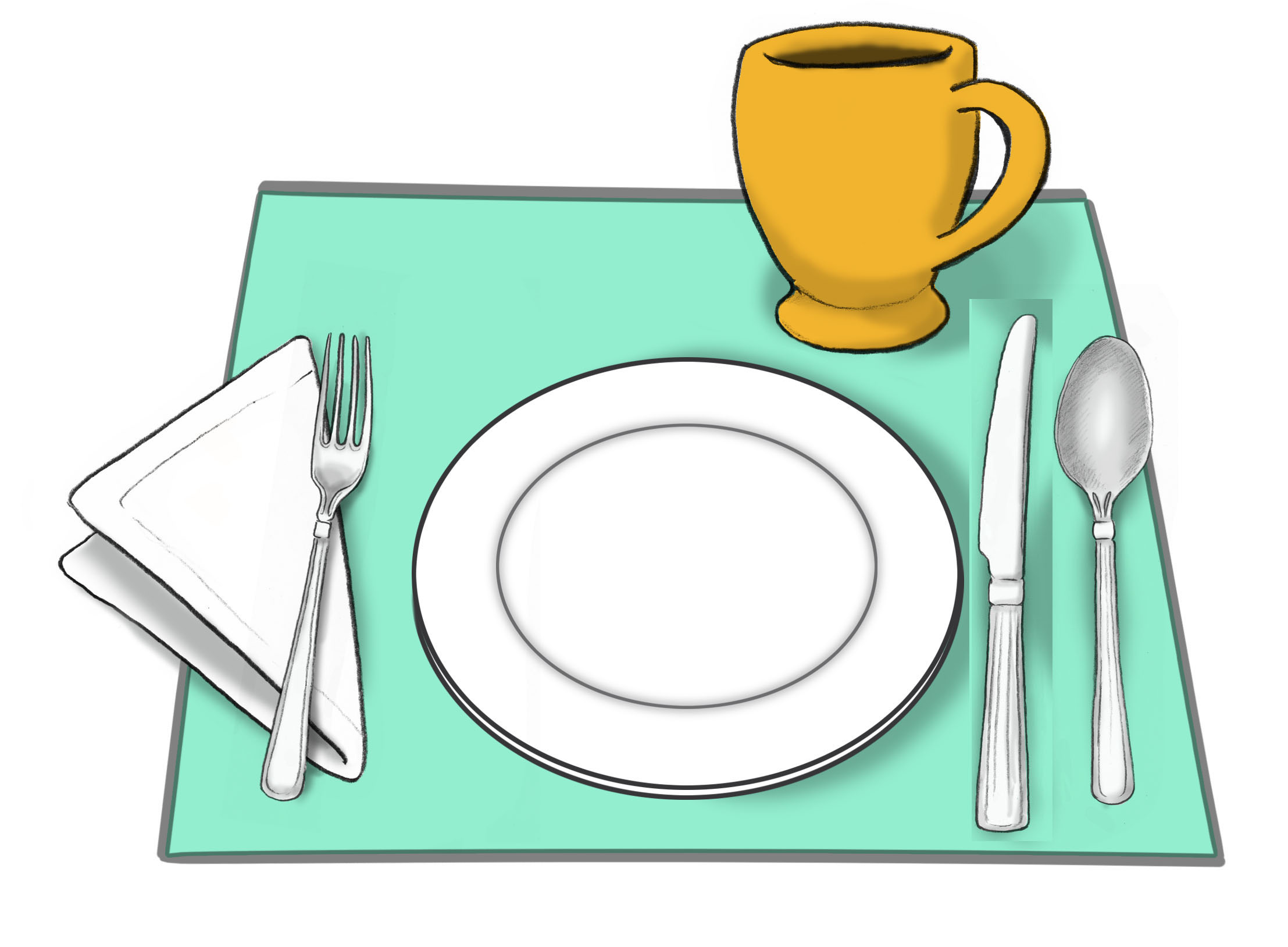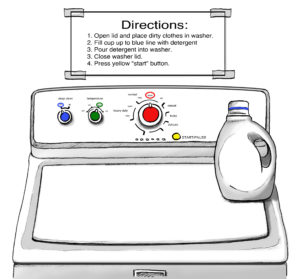Transforming Your Home
 The best home environment is one that supports the abilities of the people living there.
The best home environment is one that supports the abilities of the people living there.Moments We Relate To
We received a call that Anne had stopped eating her favorite meal of mashed potatoes and macaroni and cheese. This left Anne hungry and angry in the early evening, when she had not been before. We found that the dinner plates were an off-white color and suggested changing the plate to another color. Anne’s husband chose a dark green plate, and Anne started eating over half of her meal again.
Ellen was working on a watercolor painting activity, but we noticed she was really struggling with painting, even though she could hold the paintbrush and everything seemed fine. Ellen would get frustrated and stop painting. After observation we found that the colors in the watercolor palette did not provide enough contrast – the black, blue, purple and brown were not easy for her to see. So, we wrote the names of the colors onto the palette in bold marker for her to read. Ellen was able to paint with much less confusion and anxiety.
Sound familiar? Everyone goes through similar challeges, but the way we need to approach them may be different. Let’s get started finding your just right.
Transforming Your Home
In an ideal world, the home environment would be so well set up, or prepared, that the person could function in the environment with very little interaction from you, the care partner. Well, none of us live in an ideal world, and living with dementia brings its own set of challenges, but you can try to make little changes that make things easier for both you and the person with dementia. We are going to share a lot of ideas and examples here with you. Some may be a hit and resonate with you so much that you’ll try them right away. Other suggestions may not be quite the right fit but will hopefully inspire you to try something that might work for your situation.
Dementia Friendly Home Handout – CLICK TO DOWNLOAD PDF | 在这里下载 | ဒီ အီၤ ဖဲအံၤတက့ၢ် | यहाँ डाउनलोड गनुर्होस्
Written by Jennifer Brush, MA, CCC/SLP
 The best environment is one that supports the abilities of the people living there. For example, adding modifications such as grab bars, a wheelchair accessible ramp or a sign on the bathroom door to remind someone where the toilet is. For people with dementia, a container, hook or some place consistent to place keys and wallet or purse every time they come home can help locate frequently used items easily. Laying out clothes in the order in which they should be put on is another way of setting up the home for success.
The best environment is one that supports the abilities of the people living there. For example, adding modifications such as grab bars, a wheelchair accessible ramp or a sign on the bathroom door to remind someone where the toilet is. For people with dementia, a container, hook or some place consistent to place keys and wallet or purse every time they come home can help locate frequently used items easily. Laying out clothes in the order in which they should be put on is another way of setting up the home for success.
There are many things that change for people with dementia that we need to take into consideration when modifying their environment. Due to these changes, an environment that works for us may not work for them. Let’s look at some of the changes that we need to take into consideration to help individuals succeed.
Here are some tips related to lighting:
- Individuals with dementia require more light than younger persons.
- Be aware of shadows on tables and on the floor and make sure lighting is sufficient enough to minimize shadows.
- Control glare by avoiding fixtures with exposed light bulbs. Choose white light LED or florescent bulbs with shades.
- Use shades or sheers on windows that can be adjusted to minimize glare from the sun as needed. Curtains may also be needed in the evenings to cover windows and prevent images of people inside the home from reflecting in the windows.
- Install one or two light sensitive night lights in the bathroom to improve safety and visibility.
- Click here to learn more information about lighting and dementia
Try these tips:
- Use colored toilet seats that contrast with the toilet and with other nearby surfaces can help make these more visible and identifiable.
 Try changing the switch plate covers to a bright color that stands out from the wall so it is easier to find the light switch
Try changing the switch plate covers to a bright color that stands out from the wall so it is easier to find the light switch- Use a place mat that contrasts from the plate and the table.
- Replace clear or white plates and mugs with brightly colored ones.
- Edge steps with contrasting tape or paint to improve safety by helping to visually reinforce the change from flat surfaces to steps.
 A cue is a signal, statement or action that tells someone that they should do something. For example, a table that is set with a placemat, utensils and a napkin is a cue that a meal will be served. A sign with a picture of a toilet is a cue for the location of a bathroom. Cues can also be simple instructions that explain how to do something. By placing them near where a person completes a certain task, they can help a person to be more independent by reminding them of the steps.
A cue is a signal, statement or action that tells someone that they should do something. For example, a table that is set with a placemat, utensils and a napkin is a cue that a meal will be served. A sign with a picture of a toilet is a cue for the location of a bathroom. Cues can also be simple instructions that explain how to do something. By placing them near where a person completes a certain task, they can help a person to be more independent by reminding them of the steps.
Placing certain cues in the home can have a big impact on someone with dementia. Creating a memory center in the home can create a sense of security and reduce anxiety because the person knows just where to look for important information. This will help decrease repetitive question asking, as well as allow the person to have a sense of control over his or her own life. A memory center uses cues such as pictures, words, or auditory reminders to compensate for memory loss and lets the person focus on what he or she can do, rather than calling attention to what they can’t do.
Click here for more information on how to create a memory center in your home.
- Try to only put out items that the person will be using, such as the toothbrush and toothpaste on one side of the sink and soap on the other, rather than leaving a toothbrush, toothpaste, hair brush, cup, soap and makeup out on the bathroom countertop.
- Declutter the home from extra objects such as clothing, too many knick-knacks, newspapers and magazines. Click here for more information about when clutter impacts people with dementia.
Family gatherings may also become a challenge due to the amount of people, noise and movement in the room. Consider having a “tranquil area” set up so that the person with dementia can visit with people in a smaller and more quiet setting throughout the event.

Simple changes in the home can make a big difference!
Sign up on the home page and receive your free download: 3 Essential Tips for a Dementia Friendly Home
Hand in Hand at Home
There are simple things you can do to transform your home into a supportive place that helps your loved one with dementia function better. We are going to show you just how to do it.
What is Dementia?
Dementia isn't a specific disease. Instead, dementia describes a group of symptoms affecting memory, thinking and social abilities severely enough to interfere with daily functioning.
Transforming Your Home
The best home environment is one that supports the abilities of the people living there.
Declutter
Understand the negative impact of clutter and take steps to improve the home environment.
Enhance Lighting
Simple changes in lighting can be made in the home to help your loved one function more independently and sleep better.
Support Memory
Create a memory center in your home to reduce confusion and foster wellbeing.
Communicate Effectively
Use a style of communication that is easier for the person with dementia to understand and follow conversations.
Understand Behaviors
Make sense of unexpected behaviors and learn how to prevent them.
Walking About
Tips for understanding and preventing walking about as well as information about how to choose a locating device.
The Power of Choice
Given them every opportunity to make informed choices about their care, leisure time, clothing, food and anything else that affects their life.
Power of Purpose
We all need a reason to get out of bed each day. People with dementia need to know their life has meaning and purpose.
Hiring Home Care
Learn how to ease the transition to additional care partners find out what questions to ask.
Self-Care
Advice for taking care of yourself, learning how and where to ask for help and scheduling breaks from caregiving.
Get Started!
You can do this! Take one step at a time. Follow these steps to get started.



